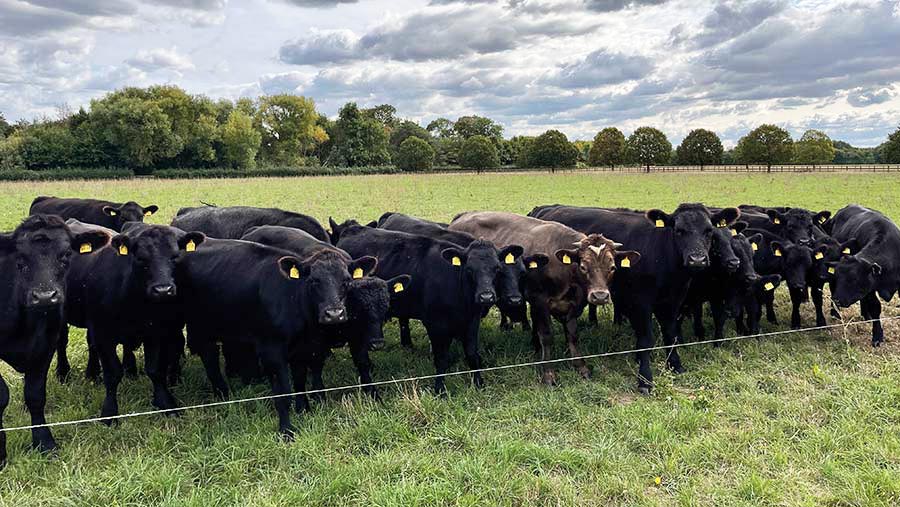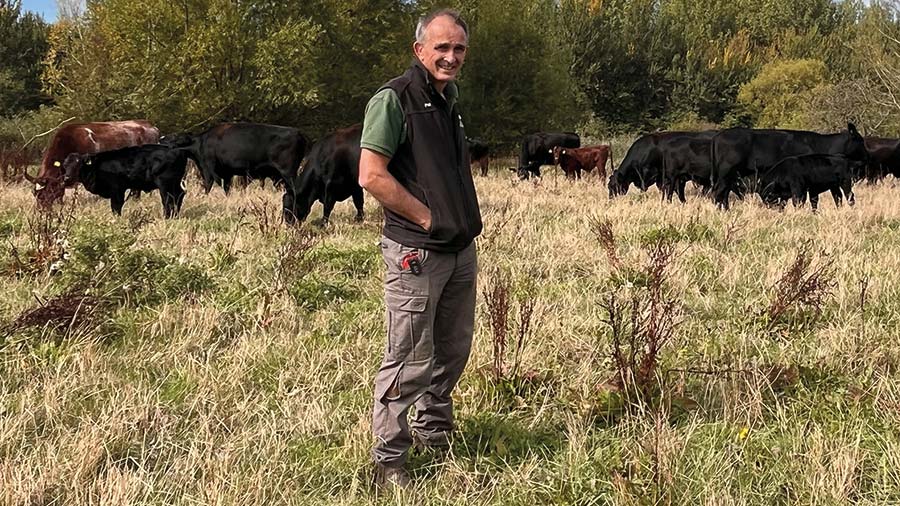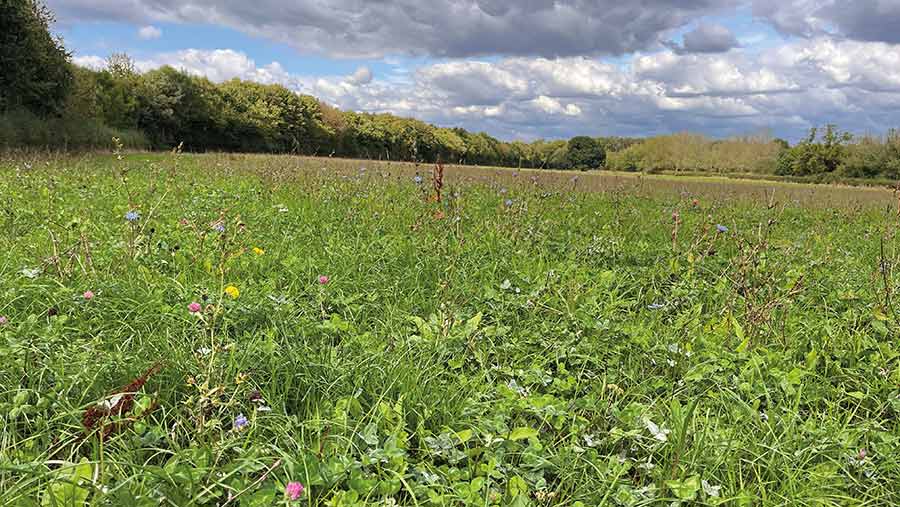How a beef farm extended grazing season by two months
 D’Oyleys Farm herd © Hayley Chapman
D’Oyleys Farm herd © Hayley Chapman Growing more grass with less nitrogen and extending the grazing season by two months has convinced Oxfordshire farmer Phil White that rotational paddock grazing is a “win-win” for a sustainable and profitable beef system.
Mr White was one of four farms involved in the McDonald’s Better Grazing Project, which saw him shift from set stocking until 2018 to full paddock grazing across the 150ha (371-acre) grazing platform at D’Oyleys Farm.
“We are, probably like a lot of farms, not in a position where we can rest on our laurels.
See also: How Cheshire suckler farm adapted to survive drought
Farm facts
D’Oyleys Farm, Oxfordshire
- 250ha (618 acres) – 150ha (371 acres) owned and 100ha (247 acres) rented
- 650mm annual rainfall across a mix of sandy loam, light gravel land and clay river meadows
- 150ha (371 acres) grazing platform with a mix of flood-plain meadows, permanent pasture, herbal leys, ryegrass and clover leys, and lucerne
- 60-70 Shorthorn and Angus sucklers – 80% spring-calving and 20% autumn-calving
- Housing finishers, but outwintering other cattle
- Also running arable, poultry, sheep and diversifications
“Faced with the prospect of phased-out BPS and a marginal profit on our grazing livestock enterprises, I started looking quite hard at improving profit, and the first place was reducing cost,” says Mr White.
He had read the Guide to Better Grazing from AHDB and started dabbling with a sward stick.
However, it was advice from James Daniel of Precision Grazing, funded by the project, that really accelerated progress.
Benefits have been abundant (see “Benefits of rotational paddock grazing at D’Oyleys Farm”, below).
Return on investment is clear, with an outlay of £5,801 on water and fencing saving him £8,908 on concentrates and nitrogen in 2021 alone.
Mr Daniel explains that to buy in the equivalent of a tonne of dry matter (DM) from pasture at 12MJ/kg metabolisable energy (ME) would cost £400-£500.
With grass growth a hectare nearly doubled at D’Oyleys, this value soon mounts up.
“Suddenly, the techniques I started to learn about enabled me to grow more grass, use less silage and use no concentrates,” says Mr White.
“We are less reliant on market price volatility, more resilient and have a lower carbon footprint.”
Benefits of rotational paddock grazing at D’Oyleys Farm
Benefits and cost savings yielded from the new grazing system include:
- Nearly doubling grass grown across the farm to 6.02t dry matter (DM)/ha, and across the three best fields to 13.43t DM/ha
- Increasing silage produced from 250t to 365t DM
- No creep feed or bought-in concentrates since 2019, without much change in weight gain (1.1kg/day liveweight gain in 2018 and 1.03kg/day in 2021)
- Outdoor lambing and calving, reducing housing costs
- Getting Pasture for Life accreditation for direct meat sales
System change
After doing what Mr Daniel calls “due diligence” – discussing paddock numbers, group sizes, pasture measurement, rotation planning and water access and flow rates – Mr White set to work on infrastructure.
“We got some geared reels, electric fence posts, a battery and an energiser and started subdividing the fields,” he explains.
“We got onto weekly plate-metre measuring, started to record on AgriNet software, walk the farm and understand what kilograms of DM were – just basic-level stuff.
“We had a target entry cover and a target residual cover and moved stock every few days.”

Phil White © Hayley Chapman
Over time, grazing management has become more responsive to weather conditions and grass growth.
In 2019, paddocks were fixed at 1ha (2.5 acres) each and multiple groups of stock were moved every few days around a set rotation.
If there was too much grass, paddocks could be dropped out of the rotation for silaging, and if there was not enough, they could look at moving stock to a different area of the farm.
Now, Mr White is more flexible on paddock size. Having broken fields up longitudinally with a hot wire, he can run temporary fences off reliable mains electricity.
“That is much more adaptable, depending on how much grass is available and how fast we want to move them,” he says.
This system is similar to the adaptive multi-paddock grazing system that nearby FAI Farms, also involved in the project, is running.
Because the farm is not a ring-fenced unit, the grazing platform has been broken down into “farmlets”, which sees the rented land treated as separate farmlets to the river meadows farmlet and the herbal leys farmlet based at home.
Not having to look at the whole platform at once makes forward planning easier.
Learnings
Mindset has been one of the biggest changes for Mr White, and he thinks that could be a barrier to other farmers adopting a different grazing practice.
“We were buying in creep feed for the calves, doing a lot of mill and mix, bringing youngstock in to house them over winter, starting up the tractor, the tub mixer, the straw bedder.
“And this has been a complete turnaround in my thinking about how I want to do the job,” he explains.
“Just moving an electric fence is not anywhere near as expensive in comparison and quite nice.”

Herbal leys on D’Oyleys Farm © Hayley Chapman
Another benefit of the system is being more aware of potential future issues.
“Because I understand pasture availability better, I know I’m not going to have enough average farm cover in November, so I need to sell some stock before then,” explains Mr White.
Having that knowledge earlier, rather than when the problem arises, allows him the flexibility to sell when the price is best.
It has not been without its challenges, and he has learned the importance of regular movement, having seen the damage done to the herbal leys when cattle are given too large a space and not moved quickly enough.
Similarly, the first time he grew fodder beet, Mr White did not back-fence paddocks and cattle walking back and forth to one water trough quickly made a mess.
But he maintains that it is not a failure as long as you learn from it.
Mr White plans to continue to invest in infrastructure to increase time efficiency, and explore the benefits of extended rest periods and tall-grass grazing.
He is focusing on Shorthorn genetics, which are giving him the lighter cow he wants for the grass-based system.
Phil White’s 5 top tips for starting paddock grazing
1. Use a consultant
- Get expert advice on grass – the biggest resource for a grazing livestock enterprise
- Shifting system may require a lot of handholding in the early days, but now Mr White is more confident, he is able to use Mr Daniel as a “sounding board”
2. Grow your knowledge
- Join a discussion group and listen to podcasts
- Having a network of likeminded individuals can be useful for learning and emotional support for when things go wrong, which they inevitably will
3. Sort infrastructure
- Invest in infrastructure, such as water and fencing, and kit such as a quad bike, as early as you can to make things efficient
- Cheaper, temporary solutions can cost in time and frustration
4. Take time to plan
- Make a plan, revisit it and adapt it as factors, such as weather, change – this is the £100/hour job you never get round to doing in a traditional system
- Knowing the state of play early gives more cost control in the business – for example, planning buffer feeding
5. Design a more resilient system
- Continually assess ways to reduce costs and simplify the system
- Insulate the business from input price volatility
- Changes might include: outwintering, deferred grazing, outdoor calving, drought planning, running fewer mobs
